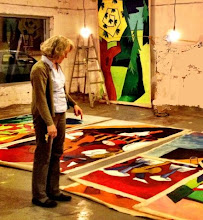
I've been watching Carol Marine for about four years. She paints in oil. She has made at least two painting demonstration videos available on youtube. I understand the basic techniques she uses and am convinced that I could paint that way. (I have done some 6x6 inch oil paintings with her techniques in mind, but realize that I'll need a few more sessions to accomplish what she is doing) The title to this painting comes from observing her titles.
Recently I watched an acrylic painting demonstration given by Rudy Kistler on youtube. I liked his video because it shows the pallet that he's working from. He explains carefully how to mix three or four values of gray in what he calls 'tones' that will be used to mix into the hues used in the painting for the various shadows. Rudy uses a very minimal pallet of three colors and white, using two of the three colors in the gray tone mixtures. I used his color method in "Let's Get Naked."
Watching a video demo on youtube of Rudy painting a cactus may help me get the colors I need for my second session to finish this painting. (I'm editing this writing on Feburary 25, 2016). The three colors he used were magenta, yellow, and thalo green. With these colors he made three initial hues: dark blue (mix green w/magenta), green (mix green w/a little yellow), and a dark gray green (mix green w/magenta and a little yellow). Then from the dark blue he made two piles of lighter values - medium and light. From the green he made three piles. the first two values had yellow mixed into the green, graduating the value lighter; and the third value took the second yellowed down value and added white. The gray green pile has three value piles by adding white and/or yellow?? to go to a light/white gray. [see this diagrammed on my April 2016 sales receipt/tax folder]
Rudy and Carol both approach their drawing for the painting the same way. I used this approach for my painting. The drawing method combined with the color tone techniques made choosing shadow/highlight colors much easier for me than my previous experiences in painting from life. I especially love the way the grays mixed with the yellows on the peeled apples to make shadows. [the grays were made with blue and red - some blues mixed with red make purple, some make gray - I had to mix ultramarine blue and phthalo turquoise to get a gray with cadmium red]
This 30 x 24 inch canvas seemed like a large surface for this experiment, but that's what I had on hand. I tried using a glass pallet for this because I noticed in at least one of Rudy's demonstrations he used glass, but I much prefer using cardboard because the acrylic drys on and stays, rather than gumming up like it does after it dries on glass.
I am a little mystified how Rudy kept his piles of paint wet till he was finished with his paintings. Wonder if maybe the paint is slow drying. I could use a slow dry medium in my paint but that's one step I'd rather avoid.
There must be a way, however, to keep the three or four piles of tone paint wet and ready to use throughout the whole paint session. When the acrylic dries it darkens, so trying to mix up a new batch to match a dry color is difficult. I tried to mix more paint before it dried.
Painting this was most enjoyable when I had all the paint and tones mixed, wet, and ready to apply. Once the paint started drying and I had to deal with mixing more color it became more intense. Having a formula to work with really made a difference for me. I like effortless work.
As I look at the photo next to the painting I see that the second step will need to bring up the tones and brighten the highlights; all of which Rudy would have done in the one session given to a painting. This next photo is a progress shot after finally getting back to it in June 2017.



No comments:
Post a Comment